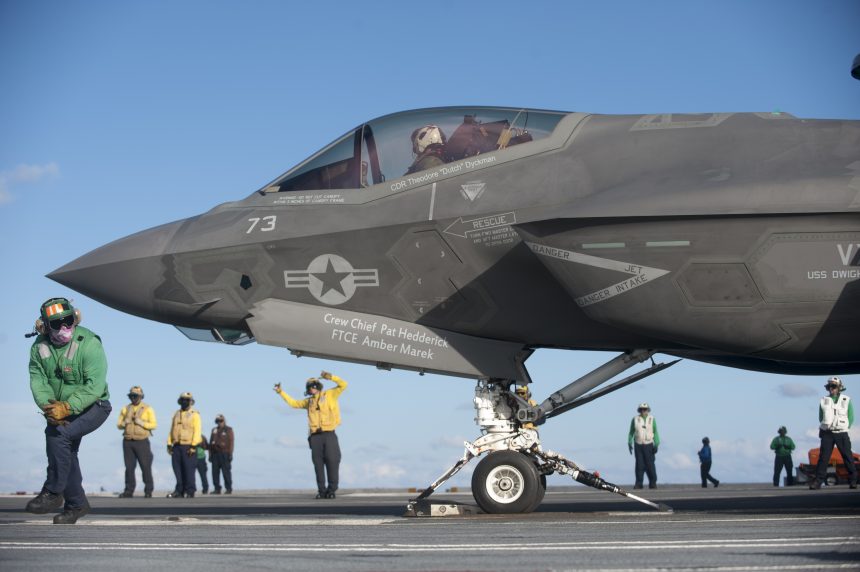Both Aircraft Landed Safely, but “Class A” Damage Sustained by F-35C in Accident.
A U.S. Navy F-35C Lightning II was damaged during a midair refueling exercise with an F/A-18F Super Hornet over the Atlantic Ocean on Tuesday according to a statement released by the Naval Air Forces Atlantic spokesman Commander Dave Hecht to United States Naval Institute News (USNI).
The F-35C, the naval variant of the Joint Strike Fighter, was flying from the aircraft carrier USS Abraham Lincoln (CVN-72). The F-35C involved in the accident returned to the aircraft carrier and landed safely aboard ship following the accident. The F/A-18F Super Hornet landed at Naval Air Station Oceana in Virginia following the accident.
The report in USNI indicated the F-35C Lightning II was from Strike Fighter Squadron (VFA) 125, the “Rough Raiders” on board the USS Lincoln. The F/A-18F Super Hornet involved in the accident was from Strike Fighter Squadron (VFA) 103, the “Jolly Rogers”.
The F-35C sustained engine damage during the accident when debris from the aerial refueling drogue being trailed by the F/A-18F Super Hornet serving as the tanker aircraft became ingested into the F-35C’s engine. There were no injuries and an official investigation is pending according to U.S. Navy sources.
The damage to the F-35C was categorized as a “Class A Mishap”, the most extensive level of damage for a military aircraft. Class A mishaps occur when an aircraft is completely destroyed, involves a serious injury or fatality or the aircraft itself sustains more than $2 million in damage. If the F-35C’s engine, a Pratt & Whitney F135 jet engine, the most powerful and advanced in its class, were destroyed in the accident it could cost as much as $14 million to replace it not including any additional damage to the aircraft’s airframe or avionics.
Damage to the F/A-18F Super Hornet was reported to be less severe and categorized as a “Class C” mishap with no injuries and damage reported to be between $50,000 and $500,000 USD according to Commander Dave Hecht.
The two aircraft involved in the accident were operating over the Atlantic and from the aircraft carrier USS Abraham Lincoln as part of an integrated air wing test. The series of tests at sea are a realistic simulation, test and training exercise of how the new Lockheed Martin F-35C Lightning II Joint Strike Fighter naval variant will interface with other combat and support aircraft from the USS Abraham Lincoln.
U.S. Navy Rear Admiral Dale Horan told reporters on board the USS Abraham Lincoln last week that the operations underway were validating how the F-35C, “Integrates with the ship, how it interoperates with communications, data links, other aircraft, and then how we conduct the mission and tie into the other aircraft that are conducting that mission and how effective they are when they do it.” Rear Admiral Horan is the director of Joint Strike Fighter Fleet Integration for the Navy.
Two U.S. Navy units are operating the new F-35C Lightning II from the USS Abraham Lincoln during the exercise, VFA-125, the “Rough Raiders” from Naval Air Station Lemoore, California and VFA-147, the “Argonauts” also from NSA Lemoore.
Prior to today’s accident the U.S. Navy forecasted that the F-35C would achieve initial operational capability (IOC) sometime in February of 2019. In order to achieve that level of operational readiness the Navy will have to demonstrate the ability to successfully operate ten F-35Cs at sea, including all support and logistical operations to maintain F-35C operations.
Of the three U.S. forces operating the F-35 Joint Strike Fighter; the USAF with the F-35A, the U.S. Marines with the F-35B STOVL variant and the U.S. Navy with the wider-wingspan F-35C model, the U.S. Navy has been the last to enter the IOC phase of operations. Some analysts suggest this is partially because of the demands placed on the Navy’s F-35C by catapult launches and arrested landings on Navy aircraft carriers.
Top Image: The accident was the first Class A mishap for a U.S. Navy F-35C Lighting II. (Photo: U.S. Navy)









